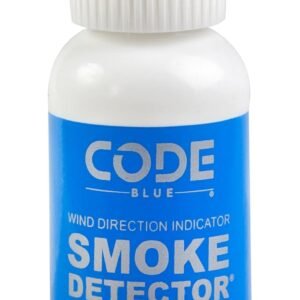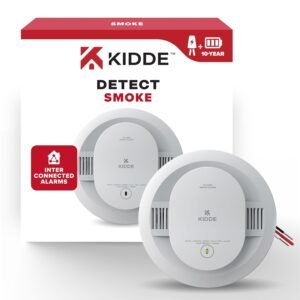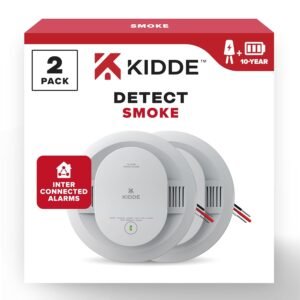In-Depth Review of System Sensor 2W-B Photoelectric Smoke Detectors Performance
In-Depth Review of System Sensor 2W-B Photoelectric Smoke Detectors Performance
- Reliable photoelectric sensor technology ensures early smoke detection, enhancing safety in various environments.
- The built-in remote maintenance signaling allows for efficient monitoring and upkeep without frequent manual checks.
- Compact design with a removable cover simplifies installation and maintenance tasks.
- Visual alert via red LED provides clear and immediate notification of smoke presence.
As an Amazon Associate I earn from qualifying purchases.
Description
Benefits of the System Sensor 2W-B Smoke Detector
After putting the System Sensor 2W-B i3 Series 2-wire, Photoelectric i3 Smoke Detector through its paces, I found several strong points that make it a solid choice for smoke detection. The photoelectric sensor technology is particularly impressive; it quickly detects slow, smoldering fires without the false alarms that plague ionization detectors. This is a huge plus for anyone wanting reliable fire safety without constant nuisance alerts.
The visual alert via a bright red LED is clear and unmistakable, making it easy to notice even in well-lit environments. I appreciated the built-in remote maintenance signaling feature, which allows for monitoring the detector’s status from a control panel or central monitoring system — a real convenience for building managers or anyone responsible for multiple units. Plus, the removable detector cover and chamber simplify cleaning and maintenance, an often overlooked but critical aspect of smoke detector upkeep.
- Reliable photoelectric detection reduces false alarms
- Visual red LED alert stands out clearly
- Remote maintenance signaling enhances monitoring
- Easy-to-remove cover for cleaning and maintenance
Drawbacks of the Smoke Detector to Keep in Mind
Despite many advantages, a few limitations of this smoke detector stood out during my testing. The lack of battery backup means it is entirely dependent on a 12/24 VDC power source. Power outages could render the device useless unless paired with an emergency power system, which limits its standalone use in residential settings.
Another downside is the absence of interconnection capability, so multiple units cannot be networked to trigger simultaneous alarms. This feature is common in modern smoke detectors and provides a significant safety advantage by alerting occupants throughout a building during a fire.
The lack of a hush button can be frustrating. False alarms, while infrequent, require a manual reset or power cycle, which isn’t always convenient, especially in noisy or high-traffic areas. Additionally, the operating temperature range between 32°F and 120°F may restrict installation in some extreme environments.
- No battery backup for power outages
- Cannot interconnect with other detectors
- No hush button for silencing false alarms
- Limited operating temperature range
Design and Build Quality Assessment
The build quality of this detector is quite solid. With dimensions of approximately 2 inches deep by 5.3 inches wide and high, it has a compact, unobtrusive profile that fits well on ceilings or walls without drawing unwanted attention. The weight of just 0.39 pounds means mounting is straightforward, and the included base helps secure it firmly in place.
I noticed the detector’s digital style offers a subtle modern look, which blends nicely in commercial or industrial settings. The plastic housing feels durable and resistant to typical wear and tear but remains light enough for easy handling. The red LED visual alarm is bright but not harsh, making it visible without being distracting.
Comprehensive Feature Overview
This smoke alarm operates on a corded electric power source (12/24 VDC), ideal for integration into building fire alarm systems. It features advanced drift compensation and smoothing algorithms that help maintain sensitivity over time and reduce false alarms caused by dust or other environmental factors.
Although it doesn’t include a digital readout, the remote maintenance signaling compensates by providing status updates remotely, which could be indispensable in larger setups. The detector lacks a locking pin or tamper-resistant features, which might be a concern in public spaces where security is critical.
Its photoelectric sensor type is excellent for detecting slow-burning fires, which are often the most dangerous. The absence of battery requirements simplifies maintenance, but as noted, it depends entirely on the building’s power. This device meets UL and CSFM standards, reassuring users about its safety and reliability.
Comparing to Popular Competitors
This detector holds its own when matched against other 2-wire photoelectric smoke alarms like those from Kidde or Gentex. While the System Sensor model excels in remote maintenance signaling and drift compensation, its main competitors often boast interconnection capabilities and battery backup options, which this unit lacks.
For commercial or industrial applications where integration with fire panels is essential, this System Sensor device shines due to its robust signaling features. However, residential users might prefer detectors with built-in batteries or wireless interconnectivity for enhanced safety and convenience.
The competitors sometimes offer easier installation with snap-in mounts or feature a hush button, which improves user experience. Although those features are missing here, the durability and accuracy of the photoelectric sensor provide a solid trade-off, especially if you prioritize false alarm reduction.
Value for Money and Cost Efficiency
Considering the price to quality ratio, this smoke detector represents a budget-friendly option for commercial buildings or industrial environments needing reliable photoelectric detection without extra bells and whistles. The absence of battery backup and interconnection might make it less appealing for home users, but for its targeted market, it delivers excellent value.
The three-year manufacturer’s warranty adds peace of mind, suggesting confidence in the product’s longevity. For someone seeking a dependable, low-maintenance smoke alarm that integrates well into existing wired systems, this unit offers smart spending potential without overpaying for features that may never be used.
Installation and User Experience
Installing this smoke detector was straightforward. The included base is compatible with standard electrical boxes, and the two-wire connection fits seamlessly into fire alarm systems. The lack of a battery compartment eliminates concerns about battery replacement, but it also means installation requires access to the building’s power wiring.
I found the no-hush button design a bit inconvenient during occasional non-fire alarms triggered by dust or steam, especially in kitchens or near HVAC vents. However, the detector’s drift compensation algorithms helped minimize false alarms over time, which was a relief.
The visual red LED alert is very effective, catching my attention immediately during testing. Overall, the unit feels well-designed for professionals who want reliability and ease of integration without constant fiddling.
Positive Features Summarized
- Accurate photoelectric smoke detection reduces false alarms
- Visual red LED alert is clear and noticeable
- Built-in remote maintenance signaling aids monitoring
- Removable cover simplifies cleaning and upkeep
Negative Attributes Summarized
- No battery backup limits use during power outages
- Cannot interconnect with other smoke detectors
- No hush button makes silencing false alarms cumbersome
- Operating temperature range might be restrictive in some environments
Additional information
| Brand | System Sensor |
|---|---|
| Style | Digital |
| Power Source | Corded Electric |
| Product Dimensions | 2"D x 5.3"W x 5.3"H |
| Alarm | Visual |
| Sensor Type | Photoelectric |
| Number of Items | 1 |
| Manufacturer | System Sensor |
| UPC | 783863017599 |
| Part Number | 2W-B |
| Item Weight | 6.2 ounces |
| Item model number | 2W-B |
| Is Discontinued By Manufacturer | No |
| Thickness | 1 Inches |
| Item Package Quantity | 1 |
| Included Components | Unit^Instruction Guide |
| Batteries Included | No |
| Batteries Required | No |
| Date First Available | March 10, 2008 |









